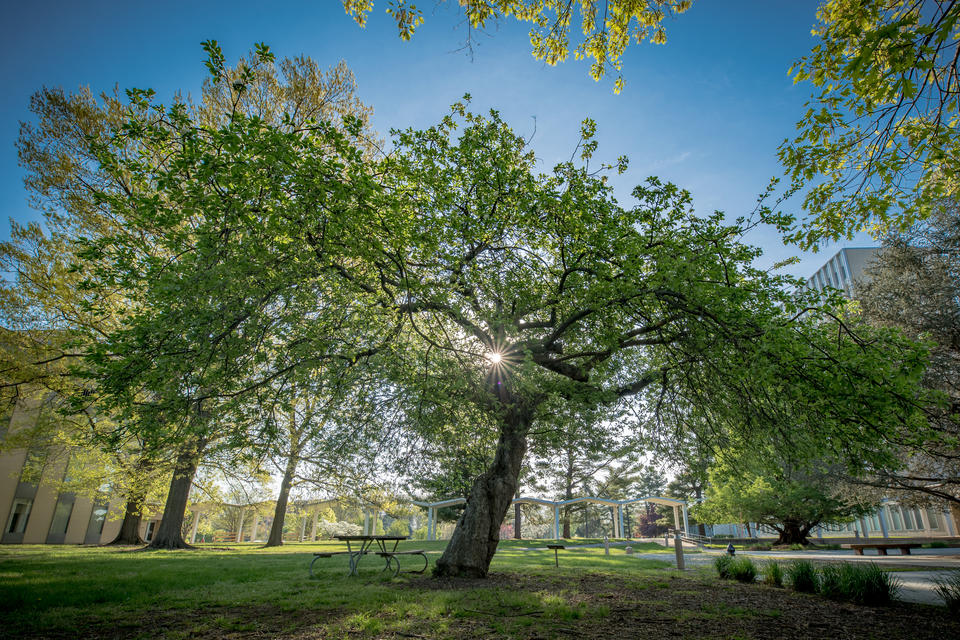Blogrige
The Official Baldrige Blog

The Newton apple tree on the NIST Gaithersburg campus
Once during Baldrige examiner training on the campus of the National Institute of Standards and Technology (NIST), someone asked me where he could find the Newton Apple Tree. I was embarrassed to admit that I couldn’t remember where on the NIST campus I had seen it.
Fast forward to 2021, and I am sad to share that, in the words of my NIST colleague Richard Wilkinson, “The Newton apple tree is dead. . . . Sometime between 5 p.m. on Monday, June 7, and 12:45 p.m. on June 8, NIST’s official Newton Apple Tree toppled over and died. This arboreal clone from the garden in which Isaac Newton saw an apple fall in 1666 has finally itself succumbed to gravity.”
Resilience
What does this have to do with Baldrige—besides being a point of interest on the NIST campus?
Well, NIST anticipated and prepared for the demise of this treasured tree. Years ago, it made several other clones of the Newton Apple Tree and planted them on campus. So, Newton lives on in Gaithersburg, MD.
And this made me think of the glossary definition of resilience in the 2021-2022 Baldrige Excellence Framework:
RESILIENCE
An organization’s ability to (1) anticipate, prepare for, and recover from disasters, emergencies, and other disruptions, and (2) protect and enhance workforce and customer engagement, supply-network and financial performance, organizational productivity, and community well-being when disruptions occur. Organizational resilience requires agility throughout the organization.
Beyond the ability to “bounce back” to a prior state when a disruption occurs, resilience means having a plan in place that allows your organization to continue operating as needed during disruptions. To achieve resilience, leaders must cultivate the agility to respond quickly to both opportunities and threats, adapt strategy to changing circumstances, and have robust governance with a culture of trust. Organizations must adopt an ecosystem mindset, embrace data-rich thought processes, and equip their employees with ongoing learning of new skills.
Of course, I realize I am vastly simplifying the term “resilience” when I mention this tree. I know there are all types of organizations who can better illustrate and tell stories of resilience—especially after the year we just had. (And we’d be happy to listen to and share those stories in Blogrige!)
The term resilience has always been a part of the Baldrige Excellence Framework and its Criteria, especially through themes such as agility (a capacity for rapid change and for flexibility in operations). In the Criteria, organizational resilience is a focus of business continuity planning. It is also a consideration for leaders, in strategic planning, for work accomplishment, and in supply-network management.
But Back to Newton
According to Wilkinson, the Newton apple tree on the NIST campus was first planted in 1966 or 1967. It was a clone or cutting genetically identical to the tree at Isaac Newton’s ancestral home of Woolsthorpe Manor in England. NIST got its apple tree from the U.S. Department of Agriculture, which in turn got its clone of the tree from the United Kingdom’s East Malling Research Station, which was derived from a cutting from the only apple tree standing in the vicinity of Woolsthorpe Manor in 1820.
Wilkinson shared that in his 1752 biography of Newton, William Stukeley wrote about meeting Newton: “We went into the garden and drank . . . under the shade of some apple trees. . . . Amidst other discourse, he told me, he was just in the same situation, as when formerly, the notion of gravitation came into his mind. It was occasion’d by the fall of an apple, as he sat in [a] contemplative mood."
Let’s hope that the concept of resilience in the Baldrige Excellence Framework will bring others the same spirit of contemplation and inspiration to anticipate, prepare for, recover, protect, and enhance—just like NIST thankfully did for our clone of the Newton Apple Tree.

Baldrige Excellence Framework
The Baldrige Excellence Framework has empowered organizations to accomplish their missions, improve results, and become more competitive. It includes the Criteria for Performance Excellence, core values and concepts, and guidelines for evaluating your processes and results.
Purchase your copy today!
Available versions: Business/Nonprofit, Education, and Health Care






Dawn,
I love this analogy! I will save this blog to use when trying to explain the term resilience.
Thank you!
d